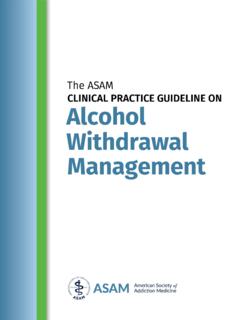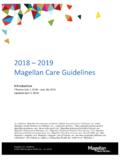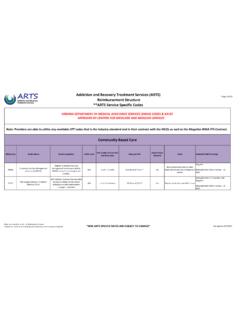Transcription of What is the ASAM Narrative? - MARETweb Project
1 the asam NarrativeWhat is the asam Narrative? ASAM is the American Society of Addiction Medicine (see ). From their website, welearn the following summary:ASAM, founded in 1954, is a professional society representing over 3,700 physicians,clinicians and associated professionals in the field of addiction medicine. ASAM isdedicated to increasing access and improving the quality of addiction treatment ,educating physicians and the public, supporting research and prevention, andpromoting the appropriate role of physicians in the care of patients with addiction.
2 the asam CriteriaASAM has developed a standardized set of criteria that can be used for assessing anyindividual for appropriateness in addictions therapy placement. Looking at the six dimensionsin the asam criteria , it is evident that the criteria can serve a much broader use than just forthe addictive recovery community. Regarding the criteria , ASAM says,ASAM's criteria , formerly known as the asam patient placement criteria , is the result ofa collaboration that began in the 1980s to define one national set of criteria forproviding outcome-orientated and results-based care in the treatment of the criteria have become the most widely used and comprehensive set ofguidelines for placement, continued stay and transfer/discharge of patients withaddiction and co-occurring conditions.
3 ASAM's criteria are required in over 30 's criteria is an indispensable resource that addiction medicine professionals relyon to provide a nomenclature for describing the continuum of addiction services. The Six Dimensions of AssessmentThe six dimensions of assessment allow for professionals to properly place individualsneeding treatment for addictions in the most appropriate setting for their care. The dimensionsallow all caregivers to see six important facets of an individual's situation that may (and do)determine the most appropriate type of care and level of care.
4 This most imminently applies toaddition medicine in its primary focus. 1 The six ASAM Dimensions are:1 Dimension #1 Acute Intoxication/Withdrawal PotentialExploring an individual s past and current substance use and #2 Biomedical Conditions/ComplicationsExploring an individual s health history and current physical #3 Emotional/Behavioral/Cognitive Conditions and ComplicationsExploring an individual's though, emotions, and mental health #4 Readiness to ChangeExploring and individual's readiness and interest in #5 Relapse/Continued Use/Continued Problem PotentialExploring an individual's unique relationship with relapse or continued use or #6 Recovery/Living EnvironmentExploring an individual's recovery or living situations, and the surrounding people dimensions as related to addiction medicine are astounding.
5 However, these sixdimensions of care are so inclusive that it is reasonable to expand their focus and use to abroader audience. The six dimensions are applicable not only to the addiction community ofcaregivers, but to the broader counseling the MARETweb Project , we have expanded the six dimensions of the asam criteria tomake them inclusive for the whole counseling community. Through the asam Narrative thatwe have created at MARETweb , you will be able to see an overall picture of a client's that picture, you will gain insight into the best approach for care whether that careis best provided by you, or if the client is best referred out to another source of moreappropriate Included on the MARETweb ASAM NarrativeIn the MARETweb Project , we expand the asam Dimensions.
6 This expansion is called theASAM Narrative. Because these dimensions are so critical to the care and proper placement1 These dimensions are taken directly from the asam website at an individual in treatment , we help you examine the appropriateness of care for eachindividual. After examining each of these areas, you should ask yourself if the individual thathas come to you for care is best suited for care with you or if they should be referredsomewhere else. The purpose of the asam Narrative is to give a counselor a comprehensive picture of theclient. This provides as an overview of the whole person.
7 It acts as a good review for lateruse, especially in the cases of referral to another agency or inclusion of another counselor. There is another use, however. the asam Narrative can provide you with a very clear pictureof who the client is. This is especially useful in helping to determine exactly what type of carethe individual needs. It will help you clarify whether or not you and the potential client are a good fit. It will be very helpful to you if you take the time to complete this form as comprehensively aspossible. Take your time. It will be beneficial both immediately and in the future.
8 You onlyneed to fill out the data that you have. If you do not have any information about a specificarea, leave it are the areas covered by the asam Narrative and the information that you shouldinclude in each of those areas. The report that will be created will be in narrative format. It iswise to create this document using complete sentences with appropriate detail for each Biopsychosocial SummaryThis should be a comprehensive verbal expression of the client's life summary. Anyonereading this, including yourself later in therapy, should get a picture of who this client may be valuable to use the Complete Biopsychosocial Summary to create Presenting IssuesThis should give the reader a clear understanding of exactly why a client has #1 - Acute Intoxication/Historic Detox Issues It is important that this point to discuss any issues related to intoxicating would include intoxicating pharmaceuticals that have been scripted by a medicaldoctor.
9 List any historic instances of overdose, addiction and detoxification events. Ifthere are substances being used, note whether or not those substances could presenta #2 - Medical and Physical Issues Explore the client's physical and medical issues. This will include previous healthissues including hospitalizations and surgeries. Chronic issues should also beincluded. Will these physical issues interfere with therapy? Are they part of the reasonthat a person needs therapy? Are they contributory? Does the client need to seemedical doctor on a regular basis?Dimension #3 - Mental, Emotional, Psychological and Behavioral Issues Document all historic mental, emotional, psychological and behavioral issues includingdiagnostics and medications.
10 This should include notation of any psychiatrichospitalizations. You may also wish to include significant family mental health #4 - Motivation and Readiness to Change Discuss the readiness of the individual to #5 - Relapse and Continued Problem Potential Discuss the potential for relapse after treatment . Relapse potential is indicated by thefact that the client has been through other therapy events throughout their life. Themore a person has been in treatment , the more likely they are to return to the sameproblem again. What is the potential for continuation of the existing problem due toenvironment or #6 - Recovery and Terminal Living Environment Explore the living environment that the individual will likely be living in when treatmentis over.




